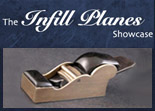Plane Handles & Totes
Handles are a very personal thing to come to grips with. They are the interface between you and the cutting edge of the tool. That all might sound a bit cheesy but it’s also a plain and simple fact. If the handle doesn’t feel right then somehow the whole tool doesn’t feel right – and to me and my own hand so many of todays tools just don’t feel right. Now before this sounds a bit like a “they don’t make them like they used to” gripe, let me just add that many of the older tools in my collection have handles that don’t sit too comfortably in my hand either. Many of my Norris, Spiers and Mathieson infill planes have vastly differing handles, and in the case of just one maker – Spiers – the range of fits and feels of handles is quite significant.
There are many elements which affect the personal comfort of a particular handle and some of them can be quite subtle or minute. The handle is not quite rounded over enough and is too “blocky” – or it’s rounded over too much. It’s a quarter of an inch too short or too long. The handle is slightly too thick or it’s not thick enough. Maybe the angle of lean just doesn’t feel right or any one of a number of other factors that contribute to the overall feel of the handle in question. This all gets down to what I call “Personal Ergonomics'”; where the usefulness of a tool goes beyond the initial design, form and function of the finished production type hand tool and more in the realm of a customised one. Don’t get me wrong, I’m not saying that a handplane with a slightly clunky or poorly finished handle will not produce beautiful work but only that a handle that sits comfortably in the hand as if it was moulded to it will, in all likelihood, make the user feel better about using it. In most cases if you feel better, you’ll produce better results. An example of this is when I had to pack some tools to take to a major woodworking trade show in which I was to demonstrate planemaking techniques. One of the paring chisels I needed to take was slightly longer than the drawer it was going to go in. Now while the chisel itself was an excellent example of a top quality turn of the century work tool, the handle was a replacement – and not much chop at that! After cutting a quarter of an inch off the end of the handle I was somewhat surprised at just how much it had changed the whole feel of the tool. This of course didn’t change the quality of the chisel per se’, but it did make holding and using it uncomfortable to such an extent that, in the end, I made do with other chisels for the duration of the show.
A similar example can be found in my own planemaking business where occasionally I am asked to turn a round knob for the front infill of a dovetailed panel or jointing plane rather than the more traditional bun or cushion infill. Requests for this modification have only ever been from woodworkers, who are very much used to their Bailey pattern type planes and are more comfortable with a round knob, rather than the collectors I sell to who are after a more authentic or traditional looking panel plane.
On a personal level I prefer the feel and look of a front cushion, even though a turned knob is quicker and easier to make. Likewise, although I’ve yet to make an open style handle for a dovetailed panel or jointing plane they were available for earlier ones of this type. They do look quite nice and I could imagine some users preferring them to the more common closed handles. Put simply that’s all there is to it. Whether you modify an existing handle or make one from scratch keep trying it out as you shape it, and you’ll soon know when your handle reaches your own level of “Personal Ergonomics”.
Tips & Tricks:
1. Most plane handles are around one inch thick – especially in the case of Bailey pattern planes. Infill planes are often slightly thicker at 1 1/8″
2. Bailey type front knobs are usually between 1 1/2″ and 1 5/8″ diameter but it really can be anything you like as long as the base fits over the plane casting. You can even make it a bun shape if you want to, or possibly a scroll.
3. Don’t necessarily think that the roundover radius is a constant one. Most of the older handles are far from it.
4. Handles and knobs can be screwed, riveted through or glued into place, depending on the type and construction of the plane they’re to be used on.
5. For strength purposes it’s not important if a handle is let into a wooden stock with a dovetail joint rather than a straight mortise. In my experience this is not where a handle breaks.
6. Don’t write off those European type knobs. Those horns might look a bit odd, but many of them are a pleasure to hold and use. Asian style planes have their handles on the sides, which help to provide a nice low centre of gravity and an even pushing stroke.
7. Bailey type handles all have different back screw angles depending on the manufacturer, the size of the plane in question and the era in which it was made.
8. Although Indian Rosewood ( Dalbergia latifolia ) is an obvious choice for Bailey replacements, often Cocobolo ( Dalbergia retusa ) is a more authentic substitute. Of course if you can find a piece of Brazilian Rosewood ( Dalbergia nigra ) this would be the best choice of all.
9. You can use any means at your disposal to shape your handle. Anything from files, rasps and sandpaper to chisels, gouges, scrapers, drill bits, sanding drums, pattern routers, grinding burrs, power sanders, spoke shaves and bobbin sanders. Also a Black and Decker power file can make short work of shaping.
10. Virtually any hard, dense and dimensionally stable timber can be used for handles and knobs, but more common ones include: Beech, Walnut, Ash, Birch, Mahogany, Maple, Cherry, Ebony and of course the Rosewoods.
11. If you’re starting out in woodworking, or haven’t made a handle before, it may be better to practice on a cheaper timber such as Oak, Ash, Maple or even Pine, rather than select grade Ebony or Rosewood.
12. It’s always a good idea to first search through your collection, or somebody else’s, to find a handle that is the most comfortable for your own hand – then copy that design.
13. If you’re making an infill plane, or replacing a handle on one, do most of your shaping before you fix your handle to the infill stock. This is also good for other wooden planes as well.
14. In the case of Bailey type knobs and handles, to make lighter coloured woods like Oak, Birch, Maple and Beech darker soak them in a dark stain rather than rub or brush it on. Also soak or dip the stained handles in lacquer or varnish for a thick, even finish, then hang them up to dry – taking care to wipe away or blend in drips.






